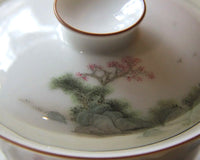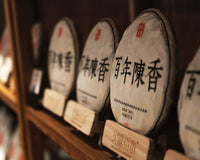The basic principle of white tea production is very simple: gradual and sustained dehydration (withering) followed by baking or drying.
Withering
Withering is the critical stage of white tea production. In other words, the main qualities that make a tea 'white' are formed during this phase. There are three main methods used: Natural Indoor Withering, Sunlight or Solar Withering and Heated Withering. Due to high dependence on favourable weather conditions, tea makers are often flexible in which method they employ and often use a combination of all three. The more stringent traditional methods eschew the use of heated withering and favour the natural method, whether indoor or outdoor.
Early spring white teas are made using Staggered Withering, which is essentially a mixture of Indoor and Solar Withering; buds and leaves are left out in the sunshine for short periods (around 20 minutes) then retrieved and placed back into the shade. Once cooled they are returned outside. This truncated method of withering is continued several times, but no longer than one to two hours total. Initial production can last a few days, and it may take a month to complete production of this tea.
Styles or Grades of White Tea
The pick determines the type. There are two principal types of white tea: 'bud' and 'bud and leaf'. These are classified further into four main grades: Silver Needle, White Peony, Gong Mei and Shou Mei.
Top grade: Silver Needle made solely from buds
Second grade: White Peony made from buds, leaves and stems
Third Grade: Gong Mei, being a 'looser' pick using buds, leaves and stems from non-premium cultivars
Fourth grade: Shou Mei. Lower grade than Gong Mei. Both Gong Mei and Shou Mei are known colloquially as 'Little White' to distinguish them from cultivars 'Big White' (Da Bai 大白) and 'Big Down" (Da Hao 大毫) which are the preferred cultivars for Silver Needle and White Peony grades.
These four grades also mirror the chronological development of white teas, the oldest being Silver Needle, the youngest, or newest, being Shou Mei.
The tasting profile of higher grade white teas is largely determined by the unusually high concentration of furry white down (trichomes) present on the buds. Kept intact during manufacturing and high in caffeine and amino acids, they contribute decisively to the brisk and stimulating characteristics of white tea - this is especially true of Silver Needle teas, whose flavour profile and appearance is dominated by the presence of these fine silver hairs.
Premium cultivars used in Fuding and Zhenghe, such as Da Bai or Da Hao, possess trichomes of above-average length and thickness.
White tea is partially or lightly oxidised; the absence of bruising or manipulation during production first restricts, then arrests, oxidisation. This light oxidation creates the mellow flavours and yellow-almond liquors found in leafy white teas such as White Peony.
A Craft of Simplicity
The production of white tea is deceptively simple, involving only two stages. Controlling and managing these two stages, however, is extremely difficult.
White tea production consists of two stages which share the same aim: dehydration. At times, the distinction between the two stages isn't always clear cut. In comparison to other tea types, white tea production couldn't appear more straightforward. After picking, buds and leaves are placed onto withering trays, left for an undetermined amount of time, heaped together then baked or dried. One could be forgiven for thinking that anyone could make white tea, such is the uncomplicated nature of its production.
Nevertheless, this apparent simplicity conceals a subtle and enigmatic process, understated perhaps, but never easy. This article seeks to draw attention to this undervalued craft.
The Critical Stage
Withering consumes the most time and causes the main physical and chemical changes; it is during withering that most of the character and qualities of white tea are shaped. Roughly three-quarters of water loss takes place during withering.
Four main factors govern the execution of withering: temperature; light; humidity and air flow. Ambient temperatures should be warm, but not excessively so; sunlight sparingly used; air flow not too fierce; the atmosphere neither muggy nor stale.
Such is the delicate nature of white tea: only a slow and steady rate of water loss will do! Achieving this balance means relying on fair weather - northern winds are best in Fujian, for they bring slightly drier and more stable conditions - yet relying on weather is a risky business. Herein lies the complexity of white tea, something which the lack of physical manipulation conceals.
One interesting feature of white tea production is that withering does not need to be efficient. There is no need for urgency. Faster dehydration only intensifies oxidation, reddening the edges and disturbing the delicate balance needed for white tea. Discolouration of the buds and leaves is the clearest sign of poorly-executed withering. Quickening the pace buys quantity at the expense of quality. Only a leisurely speed enables oxidation to begin and end naturally.
Dehydration Shock
The main theme of white tea production is the simple process of withering which causes 'dehydration shock' within the leaf, triggering a series of chemical changes. These changes transform freshly-picked buds and leaves into what we know as white tea. For higher grade white teas, this low-intensity manufacturing process also maintains the integrity of the trichomes, adding lustre to dry buds, brisk flavours to infusions, and clean 'downy' aromas to teas.
The Role of the Tea Maker
The main task of the tea maker is to create and maintain consistent and stable conditions throughout the process of withering, whilst at the same time monitoring minute changes in the physical appearance of the leaf. This is especially difficult for traditionally-made white teas that rely on the skill and experience of the tea maker to manage these conditions.
The unhurried nature of white tea processing seems uneventful, and in this apparent featureless drama the role of the tea maker is often downplayed. For much of the time, leaves are left to dehydrate on bamboo trays, manipulation of the leaf is strictly avoided, adding to the impression that its manufacture lacks craftsmanship. In reality, craft is no less fundamental to the making of quality white teas. The tea maker does play an active role, orchestrating production, carefully watching for, and responding to, changes in the colour, shape and aroma of wilting buds and leaves.
For white tea, the devil is in the details: success or failure hinges on detecting minute changes in the shape, colouring, and scent of withering material. Being able to observe and react to the changing conditions and their subsequent impact on wilting buds and leaves is the litmus test of tea makers.
There is minimal margin for error; leaves cannot be un-withered and a too rapid water loss cannot be undone. It is for this reason that white tea poses the greatest production risk of all the tea types because small errors in judgement are writ large in the leaf.
The challenge for makers of white tea is to anticipate problems and respond appropriately to any subtle changes in light, heat and humidity that may occur. To a large extent, the character of the finished white tea is shaped by these responses.
High quality tea rewards nuance: just losing the appropriate amount of water is not enough. Similarly, withering for a prescribed time, say 24 or 30 hours, also lacks the subtlety needed to shape higher quality white teas. White teas that are rushed through production and strive only to lose water quickly are often characterised by insipid liquors and flat aromas. In the leaf (or bud) they will show bright leafy, almost vegetal, greens. Equally, if withering continues for too long, excessive chemical change will take place causing a darkening effect.
Unfavourable weather, notably spikes or depressions of temperature, can spoil the delicate colouring of white teas: "Hot weather reddens, cold weather darkens." It is the tea maker who is responsible for deciding when to stop withering; ending too early or too late can under- or overcook the tea. Such is the finely poised nature of white tea production.
How Long Does Withering Take?
Withering is time-consuming even under the best conditions. Depending on the method employed and prevailing weather conditions, it can take between one to three days. The slow pace is deliberate and required, to allow chemical and physical changes in the leaf to occur gradually. On a macro-level, withering is concerned with water loss, but most of the critical and intended changes occur on a micro-level.
Withering in traditional white tea production takes between two to three days. Short-cuts are available to tea makers, such as heat-assisted withering, where specially designed rooms funnel warm air in and out over rows of bamboo trays. The trays are stacked and spaced apart to allow heated wind to pass easily between the stacked layers. Alternatively, withering troughs are used to accelerate dehydration. Heat-assisted withering can finish within 24 hours.
Three Stages of Withering
Withering can be divided into roughly three phases, each contributing to the unique character of white teas. The first stage is characterised by rapid water loss, physical shrinking, but no lasting chemical change; the second stage is when the main character and quality of white tea is formed; the final phase is less eventful, as the cumulative effect of sustained water loss begins to undermine chemical transformation.
The Chemistry of White Tea Production
White tea production functions on a simple premise: gradual and uninterrupted dehydration. This rudimentary technique, not too dissimilar from curing, creates complex but relatively unobservable change: the majority happening at the cell level.
The rapid loss of water during the first phase triggers a series of reactions within the leaf. As water is lost from the surface, the cell-liquid becomes more concentrated. This increases the permeability which, in turn, releases enzymes. The activation of these enzymes incurs three main reactions: the balance of chlorophyll compounds is disturbed, polyphenols (mainly catechins) are oxidised, and protein is broken down into amino acids. For the most part, these three chemical changes shape the final character of white teas.
The bulk of these reactions only really get going during the middle phase. Catechins continue to oxidise, converting to Theaflavins, as well as low volumes of Thearubins. Around half the catechins are lost after this phase.
Theaflavins and Thearubins are the same compounds that colour - literally and figuratively - the manufacture of black tea. Their presence in tea production confirms oxidation. Interestingly, while green tea production aims to stop this happening, for white tea it's an indispensable change.
In terms of white tea, the oxidation of catechins during this phase yellows the liquors and mellows the flavours, whilst also reducing bitterness and astringency. That this natural oxidation begins and ends without any overt manipulation of the tea maker is another hallmark of white tea manufacture.
Physical intervention (rolling or shaping, for example) or the piling together of leaves help generate heat, accelerating and deepening oxidation - some 'New Technique' white teas have added rolling and shaping to the production process. The resultant teas, in both taste and chemical terms, resemble oolong teas.
In the absence of manipulation and excess heat, oxidation comes to a natural stop; without rolling, the enzymes cannot connect with base material, so oxidation slows and enzymic activity dwindles and eventually ceases to play a decisive role in further chemical change. Additionally, significant portions of proteins are converted into amino acids, further reducing bitterness and astringency, but enhancing briskness and liveliness of the finished teas.
As withering moves into the latter stages, sustained water loss begins to alter the colour profile of wilting material. The ebb and flow between the green and yellowish Chlorophyll compounds lessens and greyish or olive greens may be noticeable in the leaf colour. At this point, the tea maker may notice changes in the condition of the buds and leaves; perhaps a slight lifting of the hairs, or a curling of the leaf. Both could indicate that withering has run its course.
The bamboo leaf-covered trays are now combined and heaped together, then left for several more hours. Afterwards, the buds and leaves are considered fully withered and ready for drying or baking.
Baking
Baking is a comparatively short, though not always straightforward, conclusion to white tea production. Various methods are used: from solar drying to electronic baking machines or, in the case of more traditional white teas - and in a manner similar to Wuyi Rock tea production - bamboo baskets over charcoal fires.
In general, baking temperatures used are quite low, between 40 to 60 degrees Celsius. Sometimes it's higher, but the baking temperature rarely exceeds 100 degrees Celsius. Precise temperatures depend upon the moisture content after withering: the drier the leaf, the lower the temperature. Baking at low temperatures with higher moisture can trigger a secondary, and unwanted, phase of oxidation.
This final stage finishes the tea by drawing out excess moisture, dispelling any remaining green aromas, and gently 'cooking' sugars and amino acids, subtly ripening the aromas. Although considered part of the traditional white tea production method, sun-dried teas are said to suffer from underwhelming aromas; being dried rather than cooked, they may retain portions of undesirable 'green' aromas. In short, heat enhances the aromatic profile - an effect known generally in tea production circles as 提香, which translates as 'lift the aroma'.
By helping to reduce bitterness and stabilising the fluctuating levels of Chlorophyll, this baking stage refines the appearance and flavour of white tea.
Physical Change
If we return to the condition of freshly-picked buds and compare those with the buds at the end of production we can observe the working of white tea production.
Freshly-picked, plump, and a sprightly, lucid green, buds immediately begin to lose water and vigour. At turns tender and shiny, then flaccid and dull, these withering buds, through continual loss of water, gradually shrink then become taut and brittle showing a silvery sheen. Taken between the finger and thumb and rubbed gently, they may crumble into a silvery dust.
The Flavour Profile of White Teas
The incremental and sustained dehydration of buds and leaves help shape the unique chemistry of white teas. Lightly oxidised and gently baked, white teas possess clean, fruity or floral aromas.
Sometimes woody, sometimes savoury, but never ripe or heavy (unless aged). Almond-yellow infusions taste both mellow and fresh without bitterness or astringency. These distinguishing traits of white tea are formed by the unique white tea chemistry.
Amino Acids in White Tea
One of the unique aspects of white tea is its unusually high level of amino acids. These are a group of compounds responsible for brisk, umami or savoury notes known to mitigate bitterness. In fact, white tea is the only tea type to contain higher volumes of amino acids than freshly-picked leaves. Of these, L-Theanine is found in particularly high quantities. L-Theanine is one chemical worthy of further investigation. Found almost exclusively in tea, it has been claimed that L-Theanine promotes both relaxation and mental alertness. It has a peculiar antagonistic effect on the absorption of caffeine, which may help to explain why teas do not produce the same 'caffeine rush' as coffees. Research has shown that white tea contains the highest volume of L-Theanine of all the caffeinated teas.
Another group of compounds that are increased by white tea manufacture are sugars - again, white tea contains the highest quantities. These may add pleasant notes of caramel and chestnut to the finished teas.
In contrast to other tea types, most notably green, white teas contain relatively low levels of polyphenols. This is especially true of the higher grade 'bud' teas. In 'leaf and bud' white teas these volumes increase and can add a mellow depth to the flavour profile.











